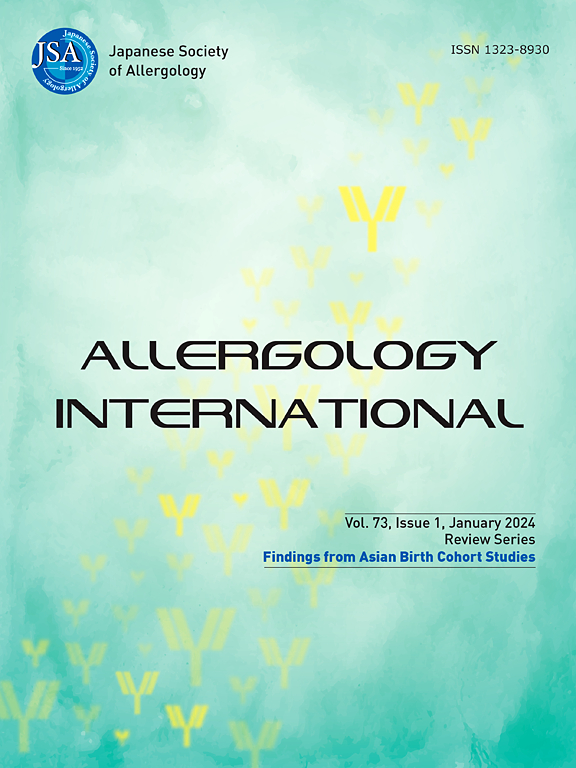Convergent monoclonal IgE antibodies from peanut allergic patients are multispecific to immunodominant epitopes of unrelated major peanut and tree nut allergens
IF 6.7
2区 医学
Q1 ALLERGY
引用次数: 0
Abstract
Background
Convergent selection has been identified in the IgE antibody repertoires of peanut-allergic individuals, primarily targeting the 2S albumin Ara h 2 and cross-reacting with two other major allergens, the vicilin Ara h 1 and the legumin Ara h 3. In this study, we aimed to investigate the structural and functional basis of this cross-reactivity and its contribution to the co-sensitization to tree nuts often observed in peanut-allergic subjects.
Methods
Six convergent antibodies, targeting the immunodominant Ara h 2-DPYSPS motif-associated sequence, and their reverted germline version, were produced as human IgG1 and IgE. Antibody specificity to natural and recombinant peanut and tree nut allergens and allergen-derived peptides was evaluated using ELISA, immunoblotting, inhibition tests, and basophil activation assays.
Results
The six antibodies showed reactivity to Ara h 1, Ara h 2, Ara h 3 and weak reactivity to tree nut legumins, especially from almond, walnut and Brazil nut. The germline antibody exclusively recognized Ara h 2. Basophils sensitized with the individual antibodies were activated by Ara h 2 at a concentration of 10 ng/ml and at 100-fold higher concentrations by Ara h 1 and Ara h 3, but not by tree nut legumins. The three Ara h 1- and two Ara h 3-derived antibody-binding peptides, with one from each group previously identified as immunodominant, are in close proximity and may contribute to conformational epitopes.
Conclusion
The biological activity of affinity-matured cross-reactive antibodies with Ara h 2-associated sequence convergence may explain the high allergenic potency of peanut and clinically irrelevant co-sensitizations to tree nuts commonly observed in peanut-allergic patients.

来自花生过敏患者的收敛性单克隆IgE抗体对不相关的主要花生和树坚果过敏原的免疫显性表位具有多特异性。
背景:在花生过敏个体的IgE抗体谱中发现了趋同选择,主要针对2S白蛋白Ara h2,并与另外两种主要过敏原,蛔虫蛋白Ara h1和豆类蛋白Ara h3交叉反应。在这项研究中,我们旨在研究这种交叉反应的结构和功能基础,以及它在花生过敏受试者中经常观察到的对树坚果的共致敏中的贡献。方法:制备6种针对Ara h 2-DPYSPS基序相关序列的趋同抗体,并将其还原为人IgG1和IgE。采用ELISA、免疫印迹、抑制试验和嗜碱性粒细胞活化试验评估对天然和重组花生和树坚果过敏原和过敏原衍生肽的抗体特异性。结果:6种抗体对arah1、arah2、arah3具有反应性,对树坚果类豆类蛋白的反应性较弱,尤其是杏仁、核桃和巴西坚果。种系抗体只识别Ara h2。被单个抗体致敏的嗜碱性细胞被浓度为10 ng/ml的Ara h2激活,Ara h1和Ara h3的浓度比Ara h2高100倍,但不被树坚果豆类蛋白激活。三个Ara h - 1和两个Ara h - 3衍生的抗体结合肽,每一组中有一个先前被确定为免疫优势,它们非常接近,可能有助于构象表位。结论:具有Ara h 2相关序列趋同的亲和成熟交叉反应抗体的生物学活性可能解释了花生高致敏效力和花生过敏患者常见的对树坚果的临床不相关的共致敏。
本文章由计算机程序翻译,如有差异,请以英文原文为准。
求助全文
约1分钟内获得全文
求助全文
来源期刊

Allergology International
ALLERGY-IMMUNOLOGY
CiteScore
12.60
自引率
5.90%
发文量
96
审稿时长
29 weeks
期刊介绍:
Allergology International is the official journal of the Japanese Society of Allergology and publishes original papers dealing with the etiology, diagnosis and treatment of allergic and related diseases. Papers may include the study of methods of controlling allergic reactions, human and animal models of hypersensitivity and other aspects of basic and applied clinical allergy in its broadest sense.
The Journal aims to encourage the international exchange of results and encourages authors from all countries to submit papers in the following three categories: Original Articles, Review Articles, and Letters to the Editor.
 求助内容:
求助内容: 应助结果提醒方式:
应助结果提醒方式:


